Above, the south side of the 100 block of East Main St., looking southeast, 1924. 112-116 East Main is the three-story structure mid-block
(Courtesy Duke Archives)
The 100 block of East Main St. was, along with 100 West Main St., the earliest retail focus in Durham. Generally, in the development of Durham, early frame structures were supplanted by brick structures, and frame structures were then constructed further to the east and west, later supplanted.. etc., etc. The brick structures in the 100 block of East Main were the 'first generation', built during the 1880s
No one, distinct, business occupied most of these structures. Rather, a parade of dozens of different businesses utilized the spaces.
The south side of the 100 block of East Main St., looking west-southwest, 1927. The banner is advertising "McFadden's Flats" at the Paris Theater across the street, which would later become the Uptown Theater. 112-116 has a fire escape on the front of the building.
(Courtesy Durham County Library)
In 1919, the tenants were;
112: Union Loan and Pawn; 114: US Woolen Mills Co.
In 1923,
112: Union Loan and Pawn; 114: US Woolen Mills Co., 116: F&F Shoe Co.
In 1929,
112: Louis Stadiem (who owned a load of houses by the 1960s,) 114: Talk of the Town Clothes Shop, 116: F&F Shoe Co.
In 1935,
112: Sample Shoe Store, 114: The Wohlmuth Co. tailors, 116: Duke Clothing Co.
By 1940,
112: United Loan and Luggage, 114: Piedmont Clothing House (women's clothing), 116: Duke Clothing Co.
1945
112: United Loan and Luggage, 114: Piedmont Clothiers, 116 Vanity Shoe Co.
The "Vanity Shoe Co." sign is visible on 116 E. Main. (Courtesy Duke Archives)
Two strange trends befell this block, which I still don't understand completely. First, a strong enough desire to change the front facade that you would remove the entire existing brick facade.
Looking southwest, 1947.
(Courtesy Duke Archives)
And secondly, removal of the upper floors of various buildings. By 1952, 112 housed The Hub, 114 Piedmont Dress Shop, and 118 the Vanity Shoe Co. Sometime shortly thereafter, the entire third floor was chopped off. Maybe just to get rid of the fire escape?
Above, the view of these buildings today - 120-124 with a 1960s era modern facade. Looking southwest, 2007.
And the view southeast of a decapitated 112-116 East Main St.
09.10.11

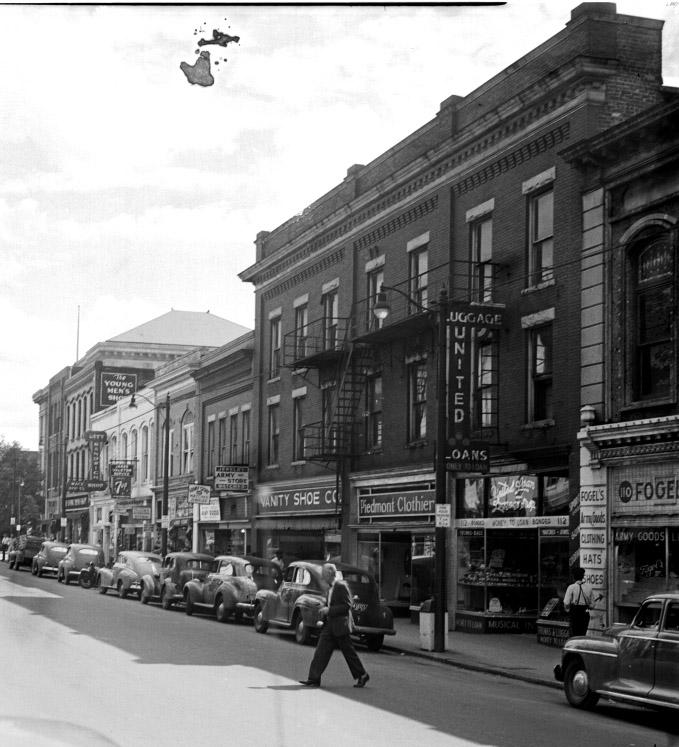


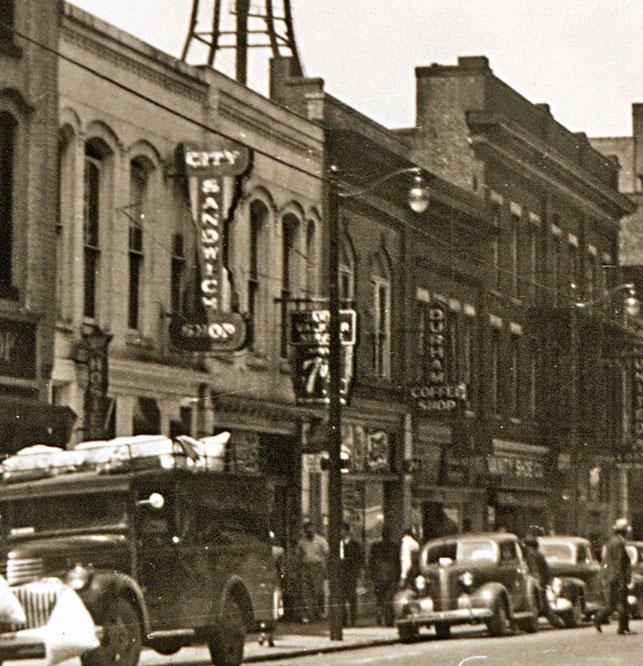
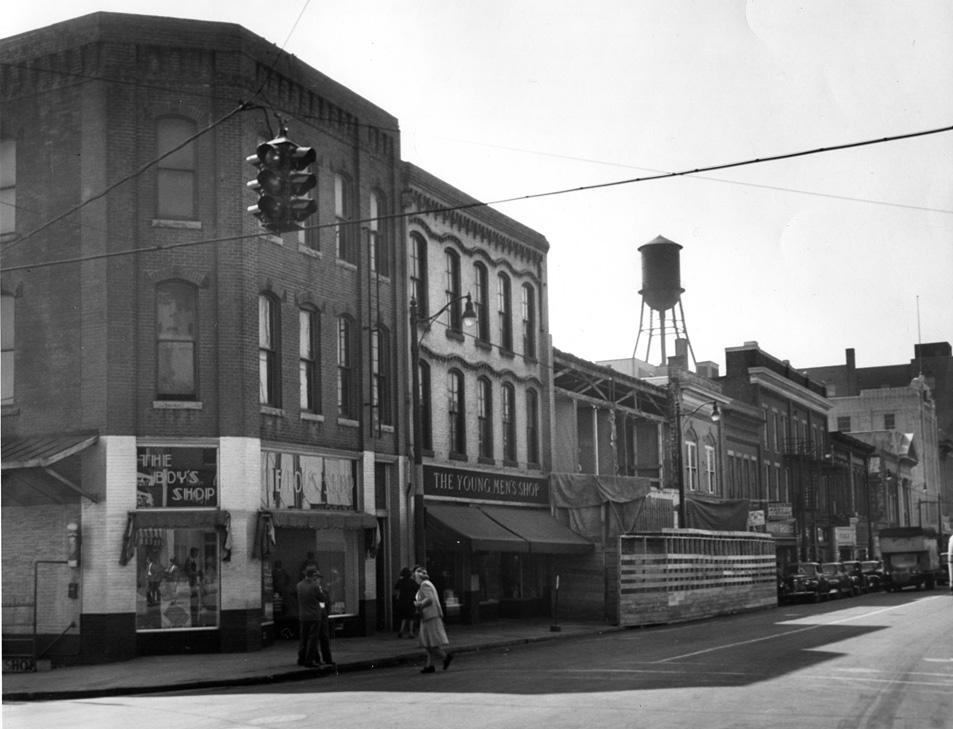
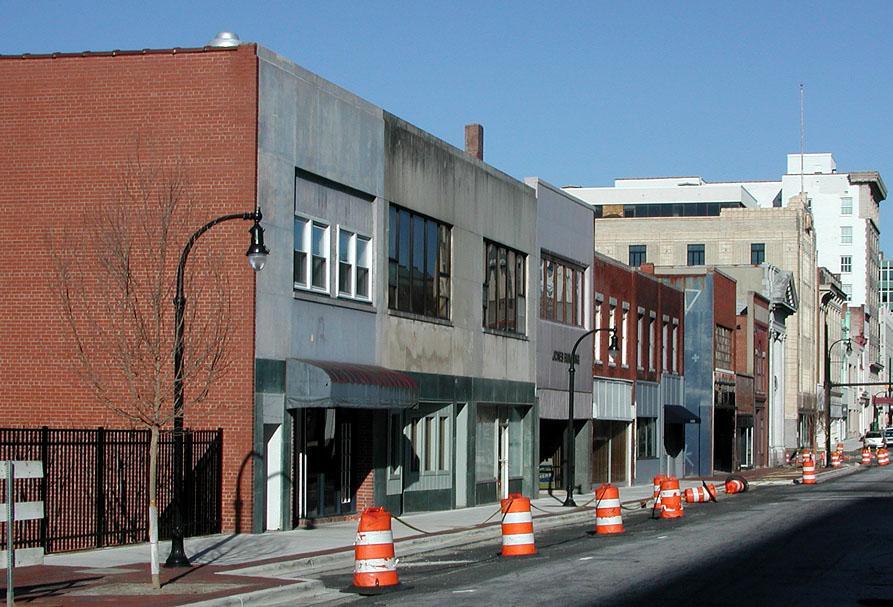
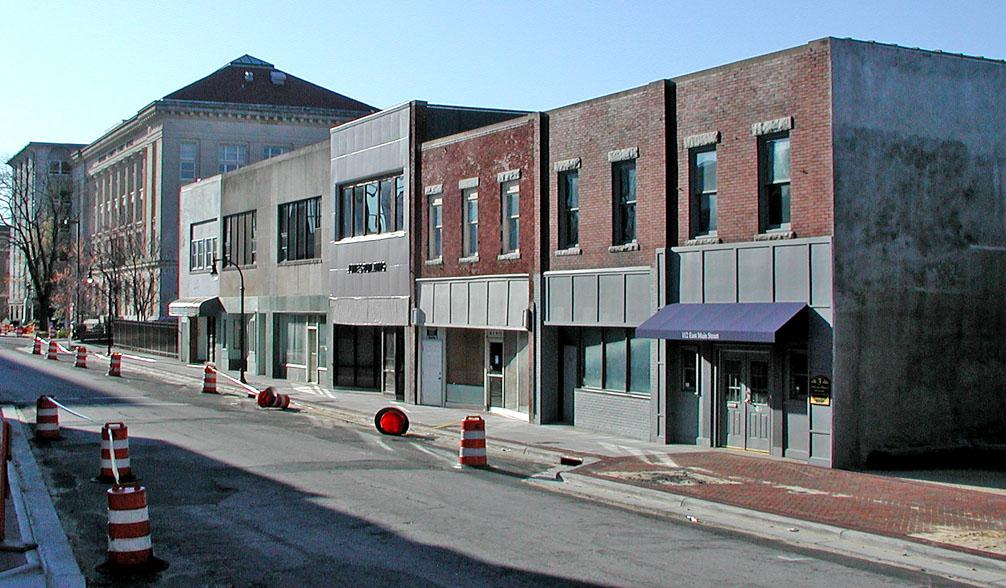

Comments
Submitted by John (not verified) on Wed, 6/6/2007 - 3:21pm
Gary,
One explanation may be the fire marshal requiring the buildings to be code compliant (a sometimes expensive endeavor) -- or removal of upper floors.
This explains why the old Duke & Sons tobacco factory, built in 1884 with four stories, is now only two. See pic here... http://www.dclibrary.net/prod1/ncc/schelp/js014.htm
Fires have played an important role in downtown's built environment -- everything from the decorative fire walls at Brightleaf... to the metal fire doors (which slide shut when flames burn through the rope) at Baldwin apts.
~John Schelp
Submitted by Gary (not verified) on Wed, 6/6/2007 - 6:07pm
John
The code enforcement piece makes sense, although it still seems like removing floors from atop one's building wouldn't be a big cost-savings over code. There was certainly a lot of grandfather-ing with code, so I'm not sure what elements would apply and which wouldn't. The oddest thing about this to me was the shrinking of older buildings while, at the same time SouthBank and 301 West Main were going up, up, up downtown.
Thanks for your input!
GK
Submitted by Carey (not verified) on Wed, 6/6/2007 - 9:17pm
Gary (et al),
I was wondering what your opinion is on preserving historic buildings that have been completely stripped of their original character. Those buildings you profiled today may have been built in the 1920s or earlier, but they appear to have nothing left of their original appearance, and in my humble opinion, look rather dull and pathetic now. I am guessing that a full restoration of their old form would be economically impossible. Hypothetically speaking, if somebody proposed a new, high-quality building(s) that respected the street, was built with high quality materials, had nice architecture, etc., would you be in favor of removal of these decapitated and compromised historic buildings for something new?
I am just curious to get people's opinions on this matter. It may be a case-by-case basis, but it is something I haven't been able to figure out myself.
Submitted by Gary (not verified) on Thu, 6/7/2007 - 12:23am
Carey
I think it's a case-by-case. I think I would start with the inside of these buildings. If there is good fabric that you could strip down to on the inside, I would opt for redoing the facades (I don't mean re-creating, which would be prohibitively expensive, as you point out.) I'm not among the preservation purists that think you should freeze an ugly building in time. I'm a big fan of the cornice added to the Professional Building on West Main, as an example.
I still try to opt for renovation, even if the inside isn't special, where feasible - addding more floors if the foundation will support, etc. That's more about sustainability (recycling) than preservation, though, for me.
I would probably have to weigh the proposed project against whatever is there - hard for me to come up with a hard and fast rule.
GK
Submitted by Anonymous (not verified) on Fri, 3/27/2009 - 2:15pm
That first building has apartments upstairs, one of which is for rent. The ceilings are very high but I would think it would not be economically feasible to make that a 3 story again. When I saw the inside I wondered why the ceilings were soooooo high and had cabinets that you have to get on a ladder to get to. LOL thanks for the explanation.
Add new comment
Log in or register to post comments.